

 The South African
The South African
At the outbreak of the Anglo-Boer War in October 1899, the Orange Free State decided to send a force of burghers and artillery to the western border of the state. Initially, this force consisted of about 1 500 burghers and four 75mm Krupp L/27 BL field guns and one 37mm Krupp L/30 QF gun. The guns were under the command of Captain (soon to be promoted to major) Richard Albrecht, who was also the commander of the Orange Free State Artillery Corps.
The Orange Free State bought fourteen 75mm Krupp L/27 guns from Krupp in Germany. The gun was similar to the well-known Krupp C/73 gun and used breech-loading technology in the form of the cylindro-prismatic wedge, first used in 1867 and more or less perfected with the C/73. The Free State's L/27 was largely obsolete by the time of the Anglo-Boer War. It had a slow rate of fire as the projectile and the charge were loaded separately, a low projectile velocity, only had brakes as a rudimentary recoil mechanism, and used black powder as a propellant which left a large white cloud after every shot and could therefore be easily detected. The gun, however, had an excellent range of 6 100m with percussion shells and 4 400m with shrapnel. It was extremely robust and quite suited for African conditions. In comparison the standard British field gun with Methuen’s force, the 15-pounder 7cwt gun had a range of 3 749m with shrapnel while the 12-pdr 12 cwt with Methuen had a range of 9 100m with percussion and about 4 500m with shrapnel. The Boers called the gun the old Krupp, or Free State Krupp, while the Germans in the Orange Free State Artillery Corps referred to it as the C/73.
The 37mm Krupp L/30 was a small mountain gun type that fired a quick-firing shell. Each shell was separately loaded, unlike the far more renowned belt-fed 37mm Maxim-Nordenfelt of the Transvaal State Artillery that had the same calibre.
After the initial Boer advance into the adjacent British colonies in October 1899, the British launched a large counteroffensive with 47 000 troops under General Redvers Buller. Buller decided to split his force into four parts and one of these under Lt-Genl. Paul Methuen was to come to the rescue of besieged Kimberley. Thus, around Kimberley, the Boer forces were reduced so that men and material could be sent to make a stand against Methuen, who confidently believed “I shall breakfast in Kimberley on Monday”. He had a force of 10 500 men – although the Highland Brigade was held back to protect his line of communication. From the outset he had 16 guns, of which four completely outclassed the guns used by the Free State Artillery. Captain Albrecht, with one Krupp L/27 gun, the 37mm Krupp L/30 gun, and one 0.45 Maxim machine gun, was consequently sent south to join the one Krupp under Sergeant-Major Antonie Raubenheimer that was already at Belmont.a
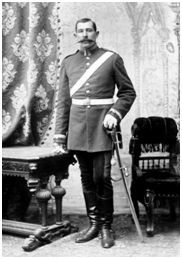
Major Richard Albrecht
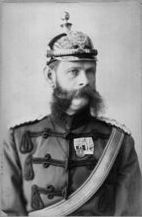
Sgt-Maj Antonie Raubenheimer
Practically every book that mentions the Boer guns used during Methuen's advance reports the number and type of guns the Boers used, inaccurately.
This is probably to do with the fact that the British observers and commanders at these battles inflated Boer numbers, including the number of field guns. This wasn’t necessarily done intentionally, but was also due to a lack of proper reconnaissance and due to the Free State gunners moving their guns around. Regarding the type of guns, a lot of sources state simple inaccuracies like “big-“ or “guns of large calibre” for the Free State 75mm or 9-pounder Krupps. The single Free State gun that caused the most confusion on this front was the 37mm Krupp L/30 which was confused by everybody as a 37mm Maxim-Nordenfelt (Pom-pom). The Free State had no Pom-poms until it received its first one from the Transvaal only in April 1900. The first 37mm Maxim- Nordenfelt on this front arrived shortly before the battle of Modder River, as was clearly stated by Sergeant Van Straaten of the Transvaal State Artillery. One can also see without doubt that when both Julian Ralph and L. March Phillipps saw and heard a Pom-pom at the Battle of Modder River, that it was a first-time experience.b
Sergeant-Major Raubenheimer and his Krupp L/27 had already been in one action when, on the 10th of November, a small commando of 300 men under Commandant van der Merwe engaged and forced back a British force consisting of 700 men with six 15-pounder guns under Colonel Gough near Belmont Station, about 87 kilometres south-west of Kimberley.c
One Krupp L/27 gun was briefly in a duel with the British 15-pounder guns from the 18th and 75th batteries from Methuen’s force at Belmont on the 22nd of November as was vividly described by burgher H.J. David.
"On the 22nd, the rednecks (a Boer epithet for British soldiers – author's comment) bombarded us with six guns. They fired so fast that Captain Albrecht was obliged to lower the barrel of our cannon and leave. A gunner was wounded and part of a spoke of the cannon was gone. About 8 o'clock in the evening, we went to collect the cannon from the hill."d
So, when the British attacked the Free State positions in earnest early the next morning, the Free State guns were not in position and didn't take part in the battle of Belmont. Methuen's men therefore had an easier task and succeeded in driving a Free State force of only about 1 500 men under General Jacobus Prinsloo from their positions.e
While Prinsloo’s burghers were hastily falling back from Belmont towards Ram- dam, General Koos de la Rey arrived at Graspan with 750 Transvaal burghers, and two Krupp L/27 guns under Sergeant Nicolaas Lamprecht and Lieut Herman Stuckenberg, Albrecht’s friend from Fauresmith. His men and the two guns positioned themselves to the west of the railway north of Graspan siding on the evening of the 23rd of November. General Prinsloo who heard of De la Rey’s arrival thereupon moved his men to the south from Ramdam and they and the guns of Albrecht and Raubenheimer and the L/30 of Corporal Pretorius occupied the small hills to the east of the railway north-east of Graspan siding at about one o’clock in the afternoon of the 24th . This put the total number of Boers at Graspan at about 2 000 burgers with four 75mm Krupps and one 37mm Krupp.f
The guns of Stuckenberg and Lamprecht on the western flank of the Boer position were already in action on the morning of the 24th, when they sent several shells close to the British armoured train, and one struck it, forcing the train back. This resulted in the death of a British officer and a trooper. It also gave Methuen the correct Boer position and numbers, until the arrival of Prinsloo’s men.
Early on the 25th of November, the British mounted infantry under Colonel Gough ran into the two 75mm Krupps of Albrecht and Raubenheimer placed on the eastern flank of the Boer position as they – the Mounted Infantry - tried to outflank the Boer position. They were confronted with such well-aimed shots they were forced to change direction to the east. They then swung northwards and ran into the accurate Mauser rifle fire from the Fauresmith burghers and were forced to stay put. This seriously hampered Methuen's plans to cut off a Boer retreat.
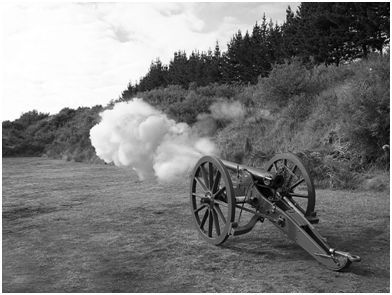
Orange Free State Krupp L/27 number 4 firing in New Zealand in 2010. The gun was one of the Krupps in action at Graspan. It was restored by Geoff Lawson and the Wanganui Regional Museum.
“They opened on us with, as I thought three, but others think two, guns, and put in some quick and well- directed shots, of which the first one or two fell short and the rest went screaming over our heads and fell among the Lancers. We retired from these guns, but when opposite the corner of the range the Lancers got on to some bad ground in front of us, and we had to halt a minute, which gave the Boer Long Tom an excellent chance of a few parting words with us. The first shell came along, making the mad noise they do, whooping and screaming to itself, and plunged into the ground with a loud snort only about thirty or forty yards off. The gunner, having got his range, was not long in sending down another, and when the white curl of smoke appeared lying again on the hillside, one guessed that the individual now on his way would prove a warmish customer. It burst with a most almighty crack, and I involuntarily bent down my head over my horse's neck. "Right over your head," shouted the next man, in answer to my question as to where it burst."h
A duel commenced with two of the enemy’s superior naval guns – Captain Dean didn’t have enough men to offload all four naval guns from the armoured train- and the six 15-pounders of the 75th RFA as Methuen tried to soften the Boer defences before an infantry assault. The Krupp shells were bursting close to or over the enemy guns. The guns of Albrecht and Raubenheimer moved to a second position and were well placed beyond the crest line, so they were quite invisible to the British gunners, except for the white smoke when they fired. One Free State Krupp, in particular, seems to have been served extremely well. According to British sources, it was difficult to silence even though the enemy shrapnel fire was accurate and vigorously sustained. The indirect fire of the unseen gun was directed by a forward observer.i
A British soldier’s description sheds more light on the duel: “Meantime, from three or four spots along the sides of those hills, locks and puffs of white smoke float out, followed at long intervals by deep, sonorous reports; and if you look to the left a bit, where our naval guns are at work, you will see the Boer shells bursting close to or over them.”
Lieutenant F.W. Dean with the 12 Pounder
naval guns described the effect of the one
or two Krupp’s fire as follows when he was
ordered by Methuen to take his guns to a new position:
"About 8 a.m. I received verbal orders to
retire from my position as the Royal Artillery
were about to move away to the right, and it
would then be untenable for my two guns.
The Royal Artillery was already moving off
when I got the order, and the Boer guns,
having got our range accurately, were
pouring on us such an effective shrapnel
fire, that I judged it impossible to carry out
the order without either leaving the guns
or suffering very heavy losses, both
amongst our own men and the company
of Royal Engineers who were helping us,
if we attempted a retreat with them."
"I, therefore, continued to fire as briskly as possible at the Boer guns, with such effect that we continuously put them out of action, first one and then the other, for as much as 15 or 20 minutes at a time. Their shells burst with the utmost accuracy, and both our guns and ammunition trolley were spattered all over with shrapnel balls; but owing to my system of making all hands lie down when we saw their guns flash, and remain till the shell burst and the balls flew by, we only had six men wounded, when, at 9:30 a.m. the Boers finally ceased firing and abandoned their position." j
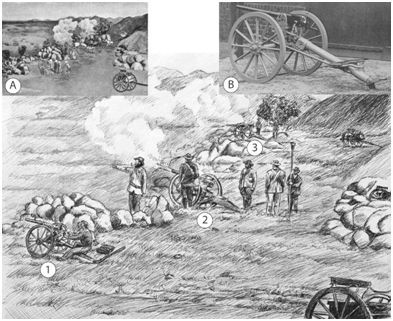
A sketch based on a watercolour painting found on the Graspan battlefield after hostilities and published in Cunliffe (A) shows the first position of the Free State guns to the east. Number 1 (B) shows the small 37mm Krupp L/30 and as can be seen from the lack of smoke as this QF gun used smokeless powder. Numbers 2 and 3 depict the 75mm Krupp guns of Major Albrecht and Sergeant Raubenheimer which could be easily detected by the large clouds of white smoke after firing black powder.
The American reporter, Julian Ralph,
also described the use of indirect fire and
excellent handling of the one persistent
Free State Krupp duelling with British
guns:
“Soon after seven o'clock the
excellent marksmanship of a gunner
behind the grassy ridge attracted the
attention, and perhaps stirred the pride,
of our gunners, and the naval battery
undertook to silence him. Then began a
very dramatic and long-sustained
combat which was a striking feature of
the battle. The Boer gun was never
seen, and the man who served it never
once saw us. His piece was hidden
beyond the ridge on the further slope,
and a comrade gave him his range and
direction.
"For a long time this gunner devoted his attention to one of our field batteries.
"Next, he attacked the black mass made by their horses and limbers. Later he paid his respects to the naval gun and its crew. He never achieved perfect excellence, for he did no damage to any British gun, he killed but two horses in the field, and he wounded but five of our men altogether. And yet he got his range so quickly and well, and he was so persistent and so wholly invisible, that our men set their teeth in grim determination to destroy him.”k
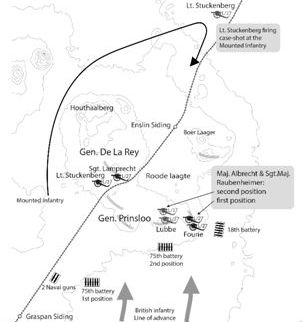
map
The little 37-mm Krupp that was quite likely under
Corporal Jacobus Pretorius, was less successful,
as can be determined by an officer of the 18th
Battery’s description:
"I had a warm time of it,
from a quick-firing gun
firing one-inch common
shell, but luckily all the
rounds (about 100) fell just about 100 yards
beyond my guns. We didn't get a scratch.
In the meantime, I plugged away at the
right hand line of kopjes but couldn't for the
life of me see where their cursed little gun
was." l

Relative positions from a field sketch
Eventually, the British numbers were
just too overpowering, and after a brave but
bloody infantry assault mainly led by the
Naval Brigade on the eastern Boer flank,
the Boers hastily started a chaotic retreat.
During the retreat, the Krupp L/27 of
Lieutenant Stuckenberg was nearly overrun
by Major Milton’s mounted infantry
north of Graspan, and the crew employed
canister (case-shot) that forced the enemy
to withdraw. Burgher Christiaan Vieweg,
from the Jacobsdal Commando, described
the scene:
“The English had by now moved far
enough along the railway line, so that they
fired at the fleeing burgers from the right. A
group of Lancers risked moving away from
the railway and storm straight at the flank of
the fleeing burgers. Luckily, a couple of
diligent O.F.S. artillerists with a Krupp gun,
who were also looking for cover, fired a few
shots at the Lancers, who then thought it
best to turn around.”
The unlucky gunner Jan Broodr˙k, was wounded and captured in this exchange. After duelling with so many enemy guns the whole day, the Free State gunners’ casualties were limited to wounded Broodr˙k and three horses killed.m
The Free State Artillery provisions wagon that was with the other provision wagons was captured together with Dr Adam Hochappel, who was a chemist in Bloemfontein and doubled as a medical officer for the corps. Bombardier Van Rensburg, and gunners J. Van Tonder, Pelser, C. Pelser, S. Van Niekerk, and C. Van Zyl were also captured.n
According to some British sources, the Free State gunners measured the distances beforehand, and that is why they had no difficulty in placing their shells so accurately, which was probably more of an attempt by the British to explain how their many guns were outgunned by a few guns. The fact of the matter is that the Free Krupp guns were just as accurate in later actions where there was no time to prepare and the guns of Albrecht and Raubenheimer to the east of the railway were just as accurate after they changed their position.o
In conclusion, the experiences of the Free State gunners on the 22nd of November at Belmont of trying to fire from a stationary position at an enemy overwhelmingly numerically superior in guns led them to adopt some new remarkable Boer tactics. Major Albrecht was at first reluctant to adopt some of these tactics as it was probably against all his formal training in the Prussian army. The first was to stay concealed, in some cases, even positioning their guns behind the crest line of the hills and using indirect fire directed by a forward observer. The Free State gunners were the first artillerists to use indirect fire in combat in the history of warfare. Indirect fire was not unknown to the various artillery branches of the world, it was just not seen as part of their tactics and thus never used. The Free State gunners also moved their guns around to evade and confuse the enemy and when they were eventually found by the British guns as to evade injuries and damage to their guns. Another major change was to remove their guns from the hills onto lower ground. This made the guns a far more difficult target for the British guns and had the added benefit that the guns would be easier to retire. These changes, and the arrival of two more guns, placed the artillery duel at Graspan in a completely different category than that of the 22nd at Belmont.p
Bibliography
Footnotes
a. Amery, L.S. The Times History of the War
in South Africa, 1899-1902. Vol II, p. 323,
Notaboek van Generaal Kolbe, and P.V.48;
Willie du Plessis Versameling.
b. Cunliffe, F.H.E. The History of the Boer
War, Vol.1. p. 191, 4128/43; Herrineringe
van W.J. van Straaten, Ralph, J. Towards
Pretoria. p. 154; Phillipps, L.M. With
Rimington. p. 26, and Boldingh, G. Een
Hollandsch Officier in Zuid-Afrika, p 86.
c. P.V.48, 3153/5; Amptelike Berigte van
verskillende Fronte, and Amery, L. Vol II,
p. 290.
d. v. 6657/1; Dagboek van H.J. David, and
Amery, L.S. Vol II, p. 325.
e. Breytenbach, J.H. Die Geskiedenis van
die Tweede Vryheidsoorlog in Suid-Afrika,
1899-1902. Vol II, p. 19.
f. A.313; J.H. De la Rey Collection:
Oorlogsherrineringe van Generaal J.H. de
la Rey and P.V.48.
g. Lancashire Evening Post, 29 November
1899.
h. Phillipps, L.M. pp. 16-18.
i. Cunliffe, F.H.E. Vol. 1, p. 186, Grehan, J
and Mace, M. The Boer War, 1899-1902. p.78,
and The Morning Post, 4 December 1899.
j. Evans, M.M. The Boer War. p. 39, and
Grehan, J and Mace, M. The Boer War,
1899-1902. p. 78.
k. Ralph, J. pp. 142,143.
l. Wilson, H.W. With the Flag to Pretoria.
Vol. 1. p.147. Corporal Pretorius died when
his Krupp L/30 received a direct hit from a
4.7-inch gun at Frederikstad on the 22nd of
October 1900.
m. 6025/1; Herrineringe van Christiaan
August Vieweg, sekretaris van die Jacobsdal
Kommando, P.V.48, and Maurice, F. History
of the War in South Africa. Vol I. p. 236.
n. 3153/5, and The Morning Post, 6 December 1899.
o. Guest, H.M. With Lord Methuen and the
First Division. p. 23, and The Morning Post, 4 December 1899.
p. 6968/2: Oorlogsherrineringe van Generaal W.J. Kolbe, p.40,
Wilson, H.W. Vol. 1. p.146, and Ralph, J. p. 142.
About the Author
Nico studied history at the University of the Free State then worked at the Free State Provincial Library and Museum Services for 16 years. He worked in commerce before moving to the south coast of Vietnam where he paints, writes and teaches English to Vietnamese children.
Return to Journal Index OR Society's Home page
South African Military History Society / scribe@samilitaryhistory.org